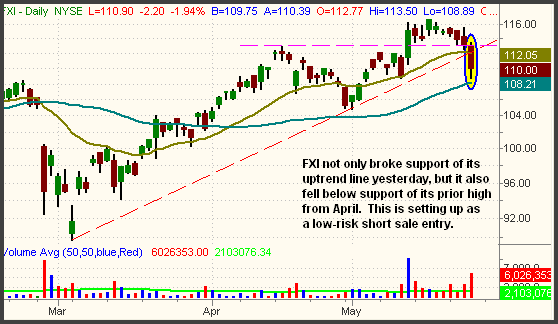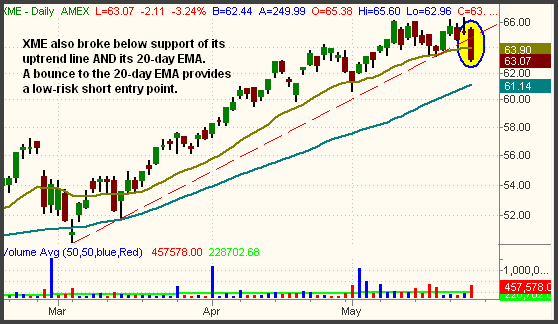|
The Wagner Daily ETF Report for May 25
Stocks followed through on the previous afternoon's weakness, as each of the major indices trended steadily lower throughout the entire session. This time, the losses actually accumulated to substantial levels and created a bit of technical damage to the daily charts. The Nasdaq Composite and small-cap Russell 2000, each of which were showing nice relative strength just a few days ago, both lost 1.5%. The S&P 500 fell 1.0%, while the Dow Jones Industrial Average closed 0.6% lower. The S&P Midcap 400 dropped 1.6%. For the second day in a row, each of the broad-based stock market indexes closed near their intraday lows.
A volume surge in both exchanges caused both the S&P and Nasdaq to register bearish "distribution days" for the second consecutive session. Total volume in the NYSE increased 12%, as volume in the Nasdaq came in 17% higher than the previous day's level. In the Nasdaq, it was the sixth such day of institutional selling in the past four weeks. The S&P and Dow have flashed less sessions of selling by mutual, pension, and hedge funds. Market internals were the worst we have seen in quite a while. Declining volume in the NYSE exceeded advancing volume by nearly 5 to 1. The Nasdaq ratio was negative by 6 to 1.
Now that stocks appear to have entered correction mode, one may wonder whether this to initiate short positions, or simply wait for a decent pullback to initiate new long positions. Part of the answer to that question depends on your time frame as a trader. If you are the type of person who is comfortable initiating a trade that you may need to close out the same day or a day later, there is nothing wrong with capitalizing on the downward momentum of the market. However, traders who prefer to hold positions for longer periods of time may be better suited to waiting in cash until stocks settle, then testing the water on the long side of the market. In addition to time frames, one must also differentiate between selling short the broad market versus specific industry sectors.
Selling short the broad-based ETFs such as SPY, DIA, or QQQQ could be tricky right now because most of the major indices are still within the confines of their primary uptrends. Frankly, there is often too much chop in the broad-based ETFs. Conversely, there are a few sectors that have already begun to break down ahead of the market. These sectors with relative weakness are the ones to consider if initiating new short positions. One such example is the iShares Xinhua China 25 Index (FXI).
On May 11, FXI broke out to close at a new year-to-date high. Strong volume also helped to confirm the move. Initially, we expected the price consolidation of the past two weeks to lead to new record highs, but the technical picture rapidly changed with yesterday's weakness. As you can see on the daily chart below, FXI closed yesterday below support of its steep, secondary trend line. More importantly, it also fell back below support of its prior highs from April:

The 50-day MA is still providing support below the current price of FXI, but a break below that level could rapidly lead it back down towards its prior lows from March. As for an entry point, there are two ways to play FXI. The first is to sell short on an opening gap up to the 20-day EMA, around the $112 level. Not only is that moving average now acting as resistance, but it also converges with new resistance of the uptrend line that FXI broke yesterday. The second potential entry point is a breakdown below the 50-day MA, just below yesterday's low. Both price levels provide valid reasons for entry, but the difference lies in the risk/reward ratios. Generally speaking, selling short a gap up into resistance or buying a gap down to support provides a very positive risk/reward ratio, but carries greater odds of the setup not making the anticipated reversal. Selling short a breakdown below support provides a less positive risk/reward ratio, but also increases the probability of follow-through to the downside. The "proper" entry point depends on your personal risk tolerance.
In addition to FXI, another ETF to consider selling short is the StreetTRACKS Metals and Mining (XME). A leader for many months, XME appears to finally be entering a corrective phase. On May 18, XME bounced off support of its 20-day EMA and attempted to rally to a new high, but it was unable to do so. Instead, XME stalled just below its prior high and reversed to close yesterday below its 20-day EMA. As with FXI, the break of the 20-day EMA corresponds to a break of the uptrend line:

As with FXI, a small gap up to the 20-day EMA in XME would provide the ideal entry point. Alternatively, we will consider selling it short below yesterday's low.
In yesterday's newsletter, we said the market could hold up if as long as the Nasdaq remained above its 20-day EMA. To the dismay of bulls, the index was unable to do so. The Nasdaq not only closed below its 20-day EMA yesterday, but it also fell below its prior highs from the beginning of May. It appears we have a false breakout in the making. The same could be said of the Russell 2000 Index (and IWM). Despite yesterday's retracements, both the S&P and Dow are still above support of their 20-day MAs. Obviously, this is a positive sign for the market. However, a close below yesterday's low in the S&P 500 would cause the index to finish below its 20-day EMA for the first time since the current rally began in mid-March. We would certainly like to enter new long positions after the market sees a healthy correction, but we first need to see confirmation of support and that the current uptrend lines in the S&P and Dow will hold. If you are not comfortable with selective short selling, cash is definitely your best option right now.
NOTE: The stock market will be closed on Monday, May 28 in observance of the Memorial Day holiday. As such, The Wagner Daily will not be published that day. Regular publication will resume on Tuesday. Enjoy the three-day weekend!
Deron Wagner is the Founder and Head Trader of both Morpheus Capital LP, a U.S. hedge fund, and Morpheus Trading Group, a trader education firm launched in 2001 that provides daily technical analysis of the leading ETFs and stocks. For a free trial to the full version of The Wagner Daily or to learn about Wagner's other services, visit MorpheusTrading.com or send an e-mail to deron@morpheustrading.com.
|